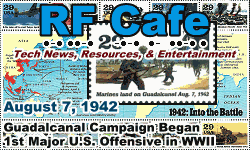|
  August 7 August 7
Today is
National Lighthouse Day. 1802:
Germain
Hess, early thermochemistry researcher who developed Hess's law of constant
heat summation, was born. 1886:
Alan
Hazeltine, inventor of the "neutrodyne" receiver
that eliminated squeaks and howls of early radio receivers, was born. 1888:
Theophilus
Van Kannel received a patent for the revolving door. 1919:
Captain
Ernest Hoy became the first pilot to fly over the Canadian Rockies. 1927: The
Peace
Bridge between the U.S. & Canada was dedicated. 1928: The U.S. Treasury
Department issued a new bill that was one third smaller than the previous bills.
1929: The German airship
Graf Zeppelin began an around-the-world flight. 1942:
U.S. Marines launched America's
first offensive in World War II, landing on the Pacific island of
Guadalcanal.
1959:
Explorer 6 transmitted the first TV photo of Earth from space.
1994: The first telephone link was made between
Israel
and Jordan. 1996: NASA announced that life may have existed on
Mars. 1996:
More than six million America Online (AOL) customers worldwide were left stranded when the system crashed
for almost 19 hours. 1998: U.S. embassies in Nairobi, Kenya, and Tanzania were
bombed killing 224 people - Osama bin Laden was later indicted
for the attacks.
| Jan
| Feb | Mar |
Apr | May |
Jun | Jul |
Aug | Sep |
Oct | Nov |
Dec |
Note: These
historical tidbits have been collected from various sources, mostly on the Internet.
As detailed in
this article, there
is a lot of wrong information that is repeated hundreds of times because most websites
do not validate with authoritative sources. On RF Cafe, events with
hyperlinks have been verified. Many years ago,
I began commemorating the birthdays of notable people and events with
special RF Cafe logos.
Where available, I like to use images from postage stamps from the country where
the person or event occurred. Images used in the logos are often from open source
websites like Wikipedia, and are specifically credited with a hyperlink back to
the source where possible.
Fair Use laws permit
small samples of copyrighted content.
|










